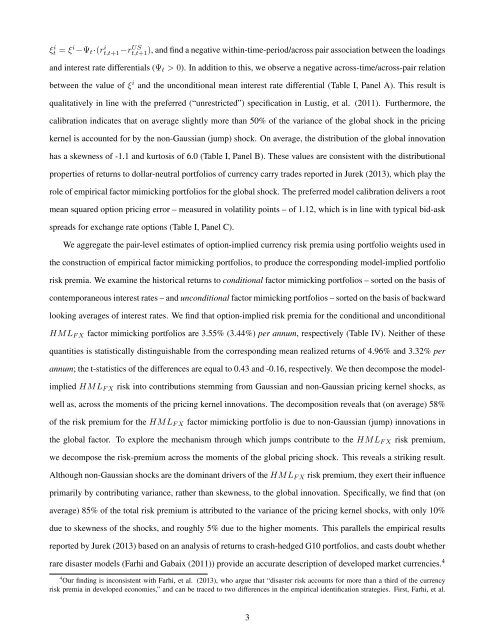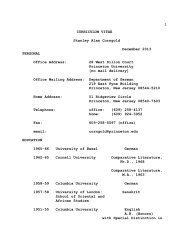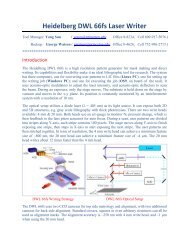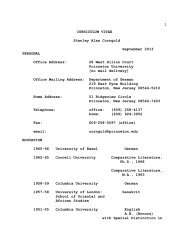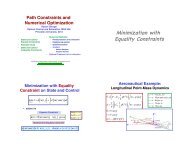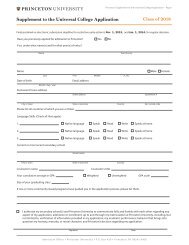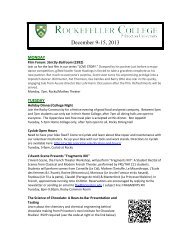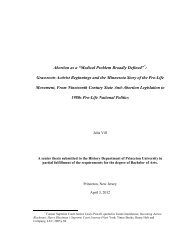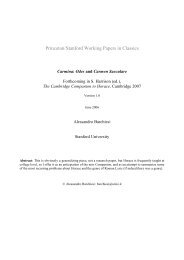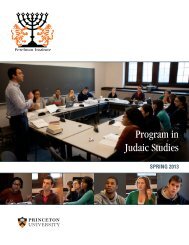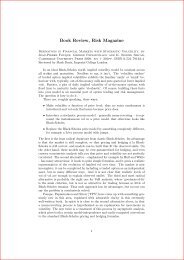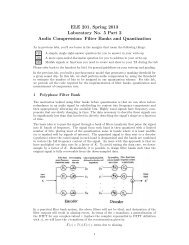Option-Implied Currency Risk Premia - Princeton University
Option-Implied Currency Risk Premia - Princeton University
Option-Implied Currency Risk Premia - Princeton University
Create successful ePaper yourself
Turn your PDF publications into a flip-book with our unique Google optimized e-Paper software.
ξt i = ξ i −Ψ t·(rt,t+1 i −rUS t,t+1 ), and find a negative within-time-period/across pair association between the loadings<br />
and interest rate differentials (Ψ t > 0). In addition to this, we observe a negative across-time/across-pair relation<br />
between the value of ξ i and the unconditional mean interest rate differential (Table I, Panel A). This result is<br />
qualitatively in line with the preferred (“unrestricted”) specification in Lustig, et al. (2011). Furthermore, the<br />
calibration indicates that on average slightly more than 50% of the variance of the global shock in the pricing<br />
kernel is accounted for by the non-Gaussian (jump) shock. On average, the distribution of the global innovation<br />
has a skewness of -1.1 and kurtosis of 6.0 (Table I, Panel B). These values are consistent with the distributional<br />
properties of returns to dollar-neutral portfolios of currency carry trades reported in Jurek (2013), which play the<br />
role of empirical factor mimicking portfolios for the global shock. The preferred model calibration delivers a root<br />
mean squared option pricing error – measured in volatility points – of 1.12, which is in line with typical bid-ask<br />
spreads for exchange rate options (Table I, Panel C).<br />
We aggregate the pair-level estimates of option-implied currency risk premia using portfolio weights used in<br />
the construction of empirical factor mimicking portfolios, to produce the corresponding model-implied portfolio<br />
risk premia. We examine the historical returns to conditional factor mimicking portfolios – sorted on the basis of<br />
contemporaneous interest rates – and unconditional factor mimicking portfolios – sorted on the basis of backward<br />
looking averages of interest rates. We find that option-implied risk premia for the conditional and unconditional<br />
HML F X factor mimicking portfolios are 3.55% (3.44%) per annum, respectively (Table IV). Neither of these<br />
quantities is statistically distinguishable from the corresponding mean realized returns of 4.96% and 3.32% per<br />
annum; the t-statistics of the differences are equal to 0.43 and -0.16, respectively. We then decompose the modelimplied<br />
HML F X risk into contributions stemming from Gaussian and non-Gaussian pricing kernel shocks, as<br />
well as, across the moments of the pricing kernel innovations. The decomposition reveals that (on average) 58%<br />
of the risk premium for the HML F X factor mimicking portfolio is due to non-Gaussian (jump) innovations in<br />
the global factor. To explore the mechanism through which jumps contribute to the HML F X risk premium,<br />
we decompose the risk-premium across the moments of the global pricing shock. This reveals a striking result.<br />
Although non-Gaussian shocks are the dominant drivers of the HML F X risk premium, they exert their influence<br />
primarily by contributing variance, rather than skewness, to the global innovation. Specifically, we find that (on<br />
average) 85% of the total risk premium is attributed to the variance of the pricing kernel shocks, with only 10%<br />
due to skewness of the shocks, and roughly 5% due to the higher moments. This parallels the empirical results<br />
reported by Jurek (2013) based on an analysis of returns to crash-hedged G10 portfolios, and casts doubt whether<br />
rare disaster models (Farhi and Gabaix (2011)) provide an accurate description of developed market currencies. 4<br />
4 Our finding is inconsistent with Farhi, et al. (2013), who argue that “disaster risk accounts for more than a third of the currency<br />
risk premia in developed economies,” and can be traced to two differences in the empirical identification strategies. First, Farhi, et al.<br />
3


